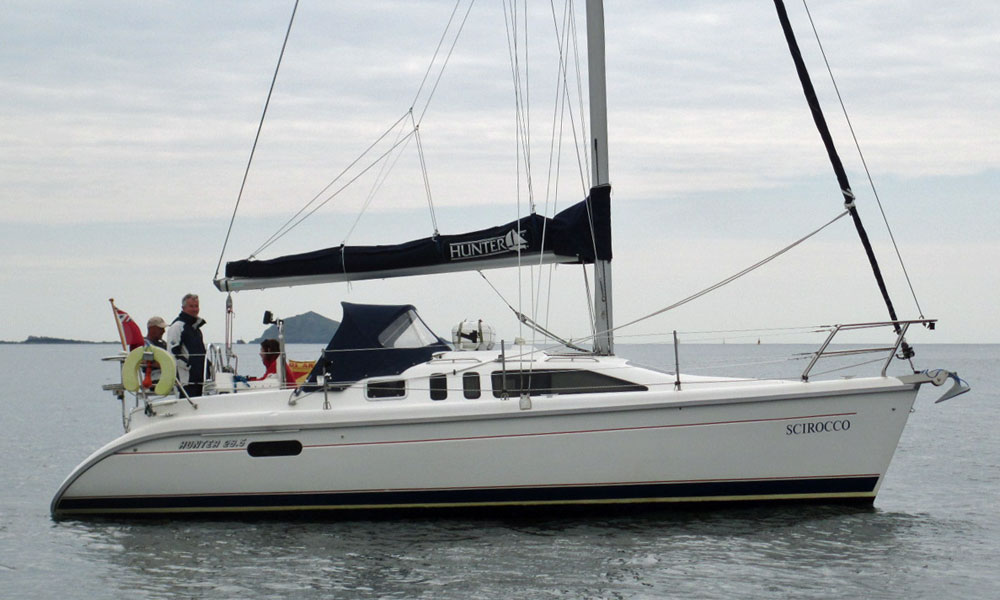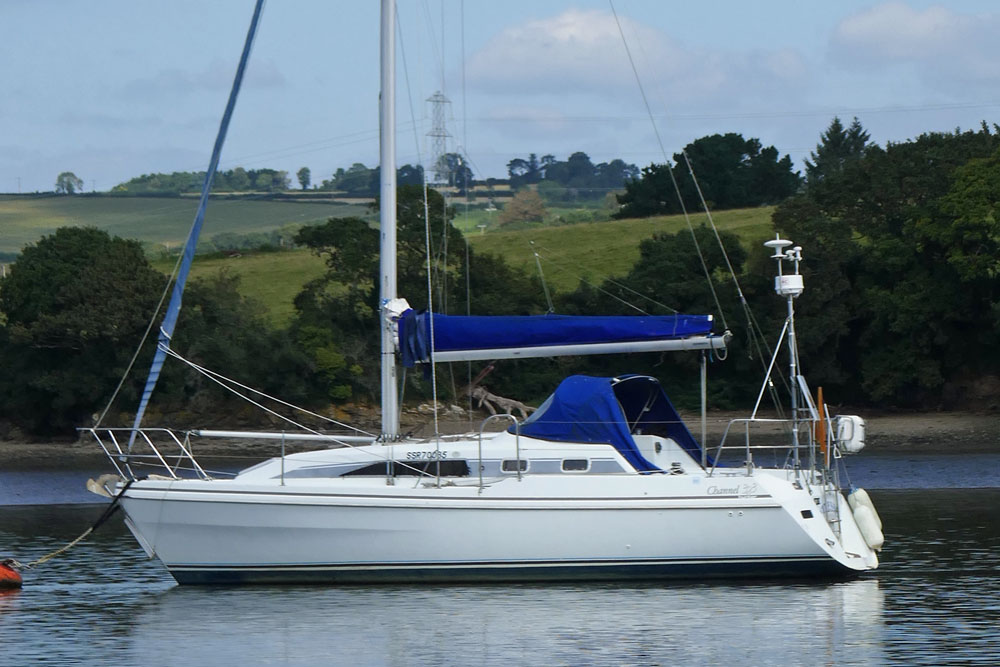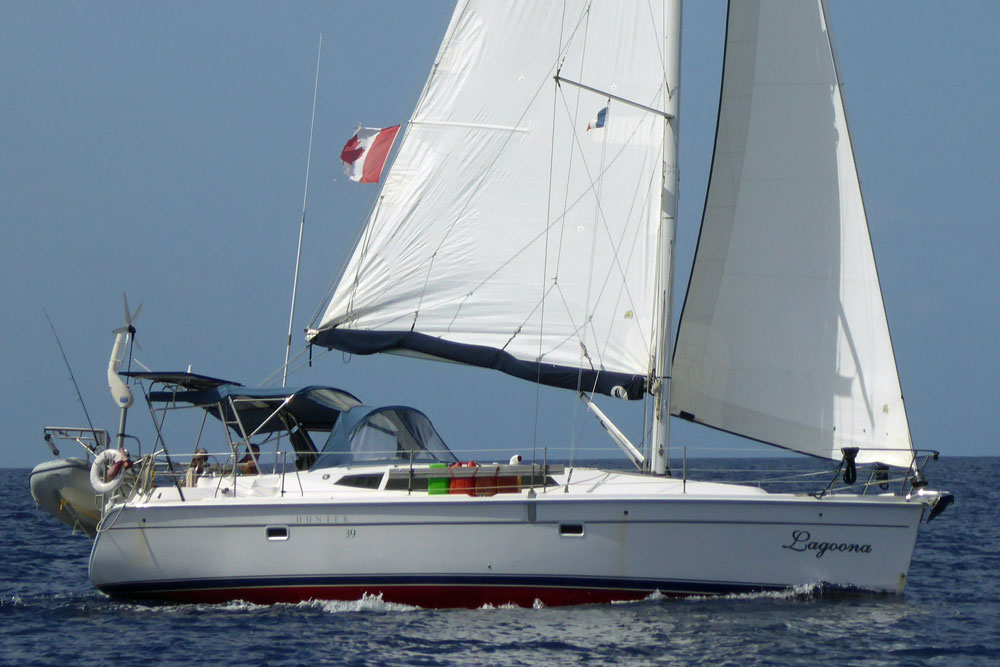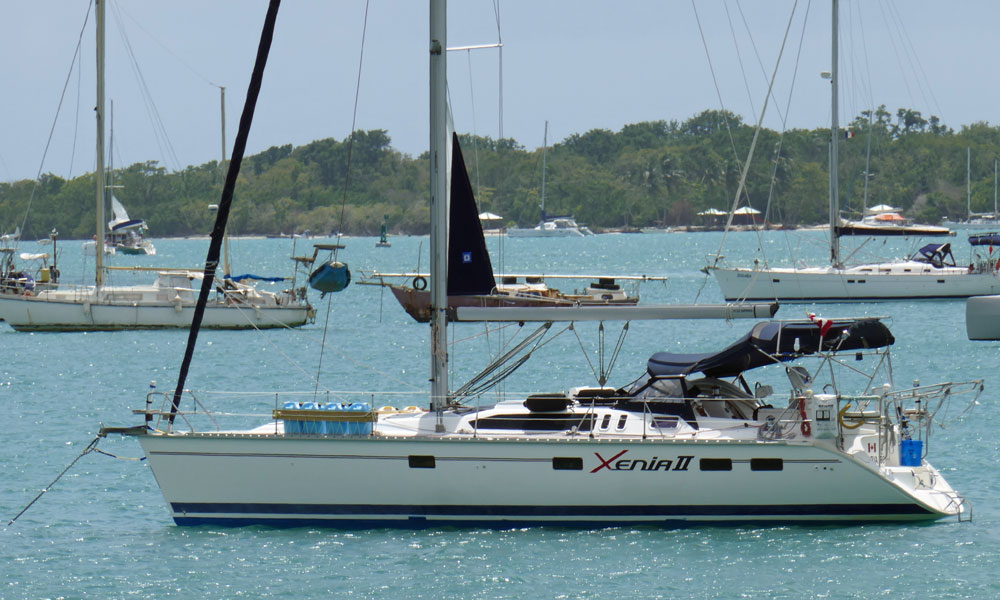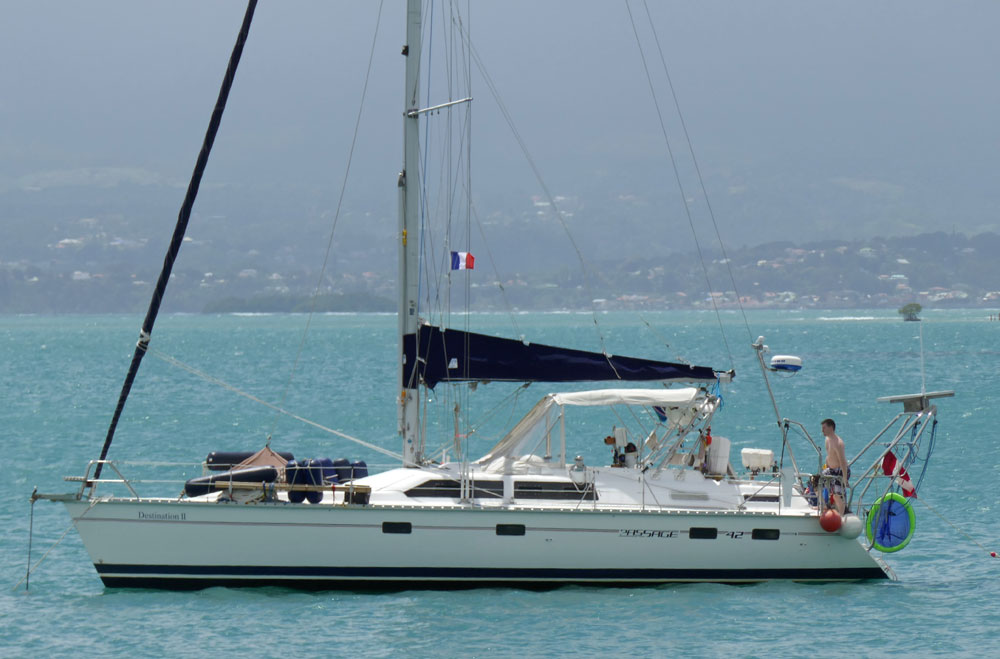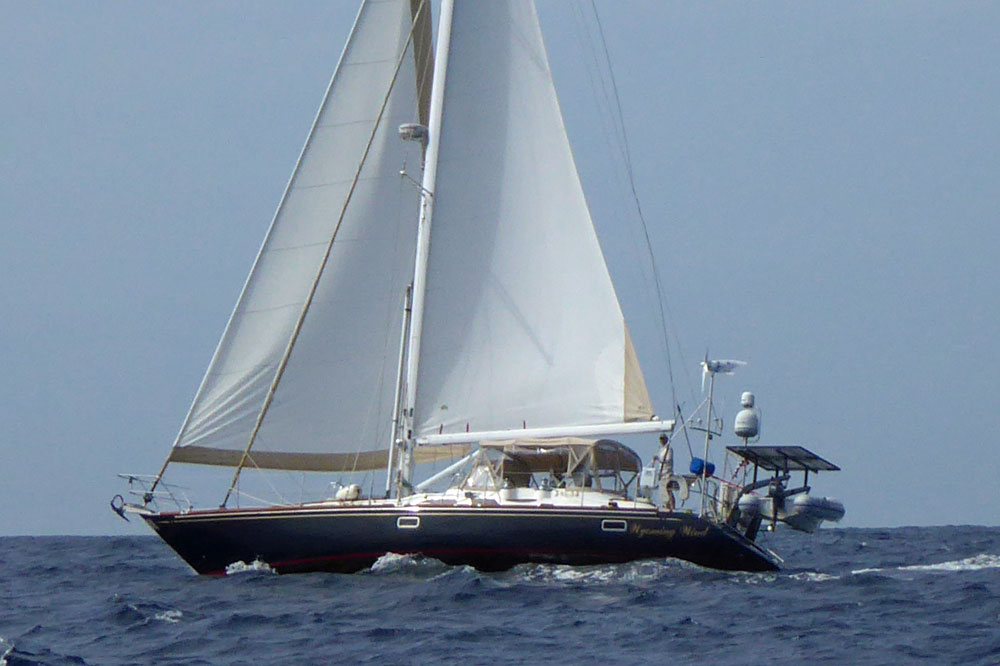- Home
- Cruising Yachts 30' to 35'
- Hunter 33
The Hunter 33 Sailboat
Specs & Key Performance Indicators
The Hunter 33 is a popular American sailboat that was designed by John Cherubini and first built in 1977 by Hunter Marine. It has a masthead sloop rig, a fixed fin keel, an inboard motor, and is known for its spacious interior, easy handling and good performance.
The boat has undergone several revisions and updates over the years, and has been compared to other sailboats in its class such as the Catalina 34, the Beneteau Oceanis 331, and the Tartan 3400.
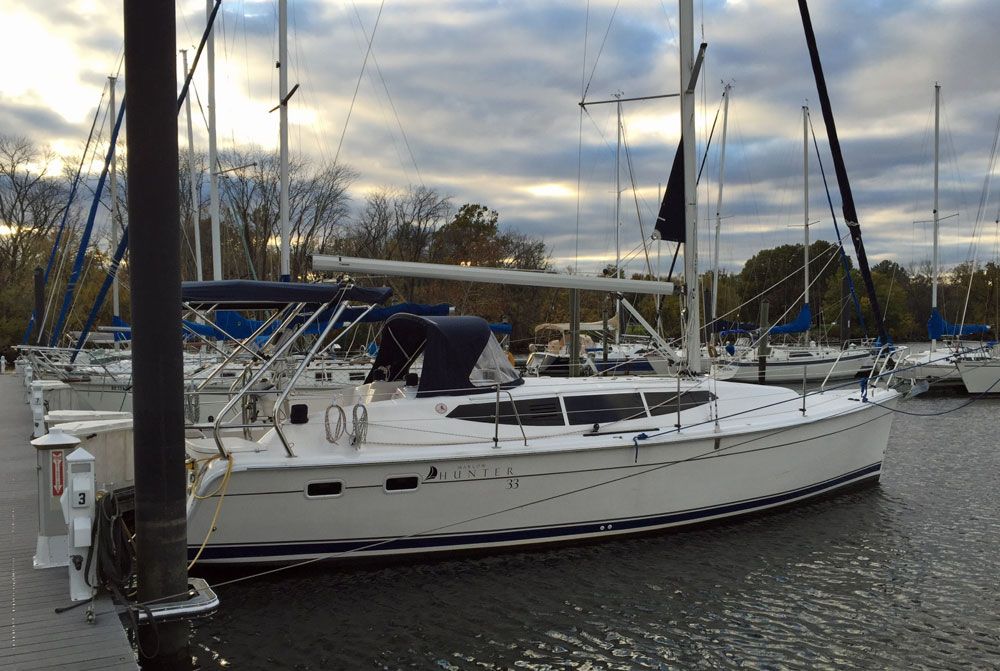 The Hunter 33e has a B&R (Lars Bergstrom and Sven Ridder) rig which negates the need for a backstay
The Hunter 33e has a B&R (Lars Bergstrom and Sven Ridder) rig which negates the need for a backstayPublished Specification for the Hunter 33
Underwater Profile: Fin with bulb keel and Spade Rudder
Hull Material: GRP (Fibreglass)
Length Overall: 33'6" (10.21m)
Waterline Length: 29'5" (8.97m)
Beam: 11'8" (3.51m)
Draft: 5'6" (1.7m)*
Rig Type: B&R
Displacement: 12,400lb (5,625kg)
Designer: Hunter Marine
Builder: Hunter Marine (USA)
Year First Built: 2012
* Shoal Draft version: 4'6" (1.4m)
Published Design Ratios for the Hunter 33
1. Sail Area/Displacement Ratio: 18.7
- Less than 16 would be considered under-powered;
- 16 to 20 would indicate reasonably good performance;
- Over 20 suggests relatively high performance.
2. Ballast/Displacement Ratio: 27.9
- Under 40: less stiff, less powerful
- Over 40: stiffer, more powerful
3. Displacement/Length Ratio: 217
- Under 100: Ultralight
- 100 to 200: Light
- 200 to 275: Moderate
- 275 to 350: Heavy
- Over 350: Ultraheavy
4. Comfort Ratio: 24.2
- Under 20 indicates a lightweight racing boat
- 20 to 30 indicates a coastal cruiser
- 30 to 40 indicates a moderate offshore cruising boat
- 40 to 50 indicates a heavy offshore boat
- Over 50 indicates an extremely heavy offshore boat
5. Capsize Screening Formula: 2.0
- Under 2.0 (the lower the better): Better suited for ocean passages
- Over 2.0: Less suited for ocean passages
A Few FAQs...
Is the Hunter 33 still in production and, if not, when did production end and how many of these sailboats were built?
Is the Hunter 33 still in production and, if not, when did production end and how many of these sailboats were built?
- The original Hunter 33 was produced from 1977 to 1984 by Hunter Marine in Alachua, Florida. A total of 1,124 hulls were built during this period.
- The second generation Hunter 33 was introduced in 2005 as an updated version of the previous model with some design changes and improvements. It was produced until 2011 by Hunter Marine in Alachua, Florida. A total of 623 hulls were built during this period.
- The third generation Hunter 33 was launched in 2012 as a completely new design with a different hull shape, deck plan, rig configuration, interior layout, and features. It was produced until 2016 by Marlow-Hunter (formerly Hunter Marine) in Alachua, Florida.
- The current generation Hunter E33 (also known as Marlow-Hunter E33) was introduced in 2017 as an electric hybrid version of the previous model with an Elco electric motor instead of a diesel engine. It is still in production by Marlow-Hunter in Alachua, Florida.
What, if any, alternative versions of the Hunter 33 were built and what are the differences between them?
What, if any, alternative versions of the Hunter 33 were built and what are the differences between them?
The original Hunter 33:
- was offered with two keel options - a standard fin keel with a draft of 5.25 feet, and a shoal draft keel with a draft of 4.0 feet.
- had a masthead sloop rig with a single spreader and no backstay.
- had a traditional transom with a small swim platform and ladder.
- had an interior layout that featured a V-berth forward, a head to port, a hanging locker to starboard, a U-shaped dinette to port, a settee to starboard, an L-shaped galley to port, and a quarter berth to starboard.
The second-generation Hunter 33:
- was also offered with two keel options - a standard fin keel with a draft of 4.5 feet, and a shoal draft wing keel with a draft of 4.0 feet.
- had a fractional sloop rig with a single spreader and no backstay, but with swept-back spreaders and shrouds that provided more support for the mast.
- had a reverse transom with a larger swim platform and ladder.
- had an interior layout that featured a V-berth forward, a head to starboard, a hanging locker to port, a U-shaped dinette to starboard, a settee to port, an L-shaped galley to starboard, and an aft cabin to port.
The third-generation Hunter 33:
- was only offered with one keel option - a fin keel with a draft of 4.5 feet.
- had a fractional sloop rig with a double spreader and no backstay, but with swept-back spreaders and shrouds that provided even more support for the mast.
- had a raised reverse transom with an even larger swim platform and ladder, as well as an arch that supported the mainsheet traveler and the optional bimini and dodger.
- had an interior layout that featured an island berth forward, a head to port, a hanging locker to starboard, an L-shaped dinette to port, two seats and a table to starboard, an L-shaped galley to port, and an aft cabin to starboard.
The current generation Hunter E33:
- has the same transom as the third-generation Hunter 33.
- has the same rig as the third-generation Hunter 33.
- has the same interior layout as the third-generation Hunter 33.
- is also only offered with one keel option - a fin keel with a draft of 4.5 feet.
How many people can sleep on board a Hunter 33?
How many people can sleep on board a Hunter 33?
- The original Hunter 33 could sleep up to five people: two in the V-berth, two in the dinette (converted into a double berth), and one in the quarter berth.
- The second-generation Hunter 33 could sleep up to six people: two in the V-berth, two in the dinette (converted into a double berth), two in the aft cabin (in either one double berth or two single berths).
- The third-generation Hunter 33 could sleep up to six people: two in the island berth forward, two in the dinette (converted into a double berth), two in the aft cabin (in one double berth).
- The current generation Hunter E33 can sleep up to six people: two in the island berth forward, two in the dinette (converted into a double berth), two in the aft cabin (in one double berth).
What is the history of the builders of the Hunter 33 and is the company still in business?
What is the history of the builders of the Hunter 33 and is the company still in business?
The builders of the Hunter 33 are Hunter Marine, which was founded in 1973 by Warren Luhrs, a successful sailboat racer who wanted to create affordable and high-quality sailboats for the mass market. The company started with a 25-foot boat called the Hunter 25, which was an instant success and sold over 2,000 units in its first year. The company then expanded its product line to include various models ranging from 15 to 50 feet in length.
The Hunter 33 was one of the most popular models, selling over 1,700 units in its first generation alone. The company also pioneered some innovative features such as the B&R rig (a fractional sloop rig with no backstay), the arch (a stainless steel structure that supports the mainsheet traveler and other accessories), and the electric hybrid propulsion system.
The company is still in business today, but under a different name and ownership. In 2012, Hunter Marine was acquired by David Marlow, a veteran boat builder who also owns Marlow Yachts, a luxury powerboat manufacturer.
The new company was renamed Marlow-Hunter and continued to produce sailboats under the Hunter brand name, as well as introducing new models under the Marlow brand name. The current product line includes sailboats from 15 to 50 feet in length, as well as powerboats from 37 to 97 feet in length.
What is the average cost of a secondhand Hunter 33?
What is the average cost of a secondhand Hunter 33?
The average cost of a secondhand Hunter 33 depends on the condition, age, equipment, and location of the boat. According to some online sources, the average cost of a secondhand Hunter 33 ranges from $20,000 to $150,000, depending on the generation and model year of the boat. For example, a 1980 original Hunter 33 in fair condition may cost around $20,000, while a 2016 third-generation Hunter 33 in excellent condition may cost around $150,000.
How does the Hunter 33 compare to other sailboats in its class?
How does the Hunter 33 compare to other sailboats in its class?
The Hunter 33 is comparable to other sailboats in its class, such as the Catalina 34, the Beneteau Oceanis 331, and the Tartan 3400. These boats are all similar in size, design, and performance, but have some differences in features, quality, and price. Some of the comparisons are:
- The Catalina 34 is slightly larger than the Hunter 33, with a length of 34.5 feet and a beam of 11.75 feet. It has a masthead sloop rig with a single spreader and a backstay, and a fin or wing keel with a draft of either 5.67 or 3.83 feet. It has an interior layout that features a V-berth forward, a head to port, a hanging locker to starboard, a U-shaped dinette to starboard, a settee to port, an L-shaped galley to port, and an aft cabin to starboard. It has a traditional transom with a small swim platform and ladder. It was produced from 1986 to 1999 by Catalina Yachts in Woodland Hills, California. A total of 1,438 hulls were built during this period. The Catalina 34 is known for its spacious interior, solid construction, and good performance. It is also more affordable than the Hunter 33, with an average cost of around $40,000 for a secondhand boat.
- The Beneteau Oceanis 331 is slightly smaller than the Hunter 33, with a length of 33.1 feet and a beam of 11.3 feet. It has a fractional sloop rig with a single spreader and no backstay, but with swept-back spreaders and shrouds that provide more support for the mast. It has a fin or bulb keel with a draft of either 5.58 or 4.25 feet. It has an interior layout that features an island berth forward or two single berths forward (depending on the version), a head to starboard or port (depending on the version), a hanging locker to port or starboard (depending on the version), an L-shaped dinette to starboard or port (depending on the version), two seats and a table to port or starboard (depending on the version), an L-shaped galley to starboard or port (depending on the version), and an aft cabin to port or starboard (depending on the version). It has a reverse transom with a large swim platform and ladder. It was produced from 1999 to 2006 by Beneteau in France and South Carolina. The Beneteau Oceanis 331 is known for its modern design, versatile layout, and good performance. It is also more expensive than the Hunter 33, with an average cost of around $60,000 for a secondhand boat.
- The Tartan 3400 is slightly larger than the Hunter 33, with a length of 34.4 feet and a beam of 11.25 feet. It has a fractional sloop rig with a double spreader and a backstay, and a fin or beavertail keel with a draft of either 6.5 or 4.75 feet. It has an interior layout that features a V-berth forward, a head to port, a hanging locker to starboard, an L-shaped dinette to port, two seats and a table to starboard, an L-shaped galley to port, and an aft cabin to starboard. It has a traditional transom with a small swim platform and ladder. It was produced from 2005 to present by Tartan Yachts in Fairport Harbor, Ohio. The Tartan 3400 is known for its classic style, high quality, and excellent performance. It is also more premium than the Hunter 33, with an average cost of around $120,000 for a secondhand boat.
The above answers were drafted by sailboat-cruising.com using GPT-4 (OpenAI’s large-scale language-generation model) as a research assistant to develop source material; to the best of our knowledge, we believe them to be accurate.
Other sailboats in the Hunter range include:
Recent Articles
-
Ohlson 38 Guide: Specs, Performance Analysis & Cruising Review
Jan 07, 26 05:52 AM
Discover the Ohlson 38 sailboat. An in-depth look at its Einar Ohlson design, Tyler GRP construction, performance ratios, and why it remains a top choice for offshore sailors. -
Passoa 47 Sailboat Review: Comprehensive Specs & Performance Analysis
Jan 04, 26 04:57 AM
Discover the Passoa 47, a legendary aluminium blue water cruiser by Garcia. Explore technical specifications, design ratios, and why its lifting keel is a game-changer for offshore sailors. -
Sailboat Wheel Steering Maintenance & Inspection Checklist
Dec 30, 25 02:32 PM
Keep your vessel’s helm responsive and reliable with our expert maintenance checklist. Master cable tensioning and system inspections to avoid mid-passage failures.
